An Intelligent Water Monitoring IoT System for Ecological Environment and Smart Cities
Abstract
:1. Introduction
2. Methodology
2.1. Field and Data Measuring System
- (1)
- Aquatic environment monitoring sensors: These sensors encompass a range of devices designed to measure water quality parameters such as pH, turbidity, temperature, and dissolved oxygen, as well as water level indicators. They were strategically positioned within each pond to facilitate real-time monitoring of the prevailing aquatic conditions;
- (2)
- ESP-32 node for data reception and transmission: The ESP-32 module played a pivotal role in the system’s functionality. Its primary responsibility was to serve as a node that receives sensor data. Data transmission occurred through a physical wired connection to ensure data integrity and reliability. The ESP-32 acted as a data intermediary, forwarding the collected information to the central control unit for processing and management;
- (3)
- Mega 2560 control unit and pump mechanism: At the heart of the system lied the Mega 2560 control unit, which controlled the pump mechanisms. Through a sophisticated control algorithm, the Mega 2560 assessed the incoming sensor data and made real-time decisions regarding pump activation and water management strategies. This centralized control unit ensured optimal water quality and level maintenance in each pond.
2.1.1. Aquatic Environment Monitoring Sensors
2.1.2. ESP-32 Node for Data Reception and Transmission
2.1.3. Mega 2560 Control Unit and Pump Mechanism
2.2. Data Storage
2.3. User Interface
3. Application Field and Result
3.1. Water Level Model Making
3.1.1. Water Level Simulation Model and Sensors’ Waterproof Measures
3.1.2. System Configuration
3.2. Water Quality Model Making
3.3. Configuration and Algorithm
4. Conclusions
Author Contributions
Funding
Data Availability Statement
Conflicts of Interest
References
- Kong, M.; Li, Y.; Zang, C.; Deng, J. The Impact Mechanism of Climate and Vegetation Changes on the Blue and Green Water Flow in the Main Ecosystems of the Hanjiang River Basin, China. Remote Sens. 2023, 15, 4313. [Google Scholar] [CrossRef]
- Fleet, C.F.; Siebert, K.J. Effect of Illumination Intensity on Visual Perception of Turbidity. Food Qual. Prefer. 2005, 16, 536–544. [Google Scholar] [CrossRef]
- Gaiani, C.; Scher, J.; Schuck, P.; Desobry, S.; Banon, S. Use of a Turbidity Sensor to Determine Dairy Powder Rehydration Properties. Powder Technol. 2009, 190, 2–5. [Google Scholar] [CrossRef]
- Parra, L.; Rocher, J.; Escrivá, J.; Lloret, J. Design and Development of Low-Cost Smart Turbidity Sensor for Water Quality Monitoring in Fish Farms. Aquac. Eng. 2018, 81, 10–18. [Google Scholar] [CrossRef]
- Hoekstra, A.Y. Green-blue water accounting in a soil water balance. Adv. Water Resour. 2019, 129, 112–117. [Google Scholar] [CrossRef]
- Misra, A.K. Climate change and challenges of water and food security. Int. J. Sustain. Built Environ. 2014, 3, 153–165. [Google Scholar] [CrossRef]
- Zhang, W.; Shao, H.; Sun, H.; Zhang, W.; Yan, Q. Optimizing Carbon Sequestration in Forest Management Plans Using Advanced Algorithms: A Case Study of Greater Khingan Mountains. Forests 2023, 14, 1785. [Google Scholar] [CrossRef]
- Searchinger, T.D.; Hamburg, S.P.; Melillo, J.; Chameides, W.; Havlik, P.; Kammen, D.M.; Likens, G.E.; Lubowski, R.N.; Obersteiner, M.; Oppenheimer, M.; et al. Fixing a critical climate accounting error. Science 2009, 326, 527–528. [Google Scholar] [CrossRef]
- Spittlehouse, D.L.; Stewart, R.B. Adaptation to climate change in forest management. J. Ecosyst. Manag. 2003, 4, 1. [Google Scholar] [CrossRef]
- Bridgland, D.G. River terrace systems in north-west Europe: An archive of environmental change, uplift and early human occupation. Quat. Sci. Rev. 2000, 19, 1293–1303. [Google Scholar] [CrossRef]
- Chunn, D.; Faramarzi, M.; Smerdon, B.; Alessi, D. Application of an Integrated SWAT–MODFLOW Model to Evaluate Potential Impacts of Climate Change and Water Withdrawals on Groundwater–Surface Water Interactions in West-Central Alberta. Water 2019, 11, 110. [Google Scholar] [CrossRef]
- Faramarzi, M.; Srinivasan, R.; Iravani, M.; Bladon, K.D.; Abbaspour, K.C.; Zehnder, A.J.B.; Goss, G.G. Setting up a hydrological model of Alberta: Data discrimination analyses prior to calibration. Environ. Model. Softw. 2015, 74, 48–65. [Google Scholar] [CrossRef]
- Bailey, R.T.; Wible, T.C.; Arabi, M.; Records, R.M.; Ditty, J. Assessing regional-scale temporal patterns of groundwater-surface water interactions using a coupled SWAT-MODFLOW model. Hydrol. Process. 2016, 30, 4420–4433. [Google Scholar] [CrossRef]
- Masud, M.B.; McAllister, T.; Cordeiro, M.R.C.; Faramarzi, M. Modeling future water footprint of barley production in Alberta, Canada: Implications for water use and yields to 2064. Sci. Total Environ. 2018, 616–617, 208–222. [Google Scholar] [CrossRef]
- Pahl-Wostl, C. Transitions towards adaptive management of water facing climate and global change. Water Resour. Manag. 2006, 21, 49–62. [Google Scholar] [CrossRef]
- Bi, M.; Wan, L.; Zhang, Z.; Zhang, X.; Yu, C. Spatio-Temporal Variation Characteristics of North Africa’s Climate Potential Productivity. Land 2023, 12, 1710. [Google Scholar] [CrossRef]
- Cao, D.; Zhang, J.; Xun, L.; Yang, S.; Wang, J.; Yao, F. Spatiotemporal variations of global terrestrial vegetation climate potential productivity under climate change. Sci. Total Environ. 2021, 770, 145320. [Google Scholar] [CrossRef] [PubMed]
- Maes, W.H.; Heuvelmans, G.; Muys, B. Assessment of land use impact on water-related ecosystem services capturing the integrated terrestrial—Aquatic system. Environ. Sci. Technol. 2009, 43, 7324–7330. [Google Scholar] [CrossRef]
- Neethirajan, S. AI in Sustainable Pig Farming: IoT Insights into Stress and Gait. Agriculture 2023, 13, 1706. [Google Scholar] [CrossRef]
- Elijah, O.; Rahman, T.A.; Orikumhi, I.; Leow, C.Y.; Hindia, M.N. An overview of Internet of Things (IoT) and data analytics in agriculture: Benefits and challenges. IEEE Internet Things J. 2018, 5, 3758–3773. [Google Scholar] [CrossRef]
- Rejeb, A.; Rejeb, K.; Abdollahi, A.; Al-Turjman, F.; Treiblmaier, H. The Interplay between the Internet of Things and agriculture: A bibliometric analysis and research agenda. Internet Things 2022, 19, 100580. [Google Scholar] [CrossRef]
- Almalki, F.A.; Alsamhi, S.H.; Sahal, R.; Hassan, J.; Hawbani, A.; Rajput, N.S.; Abdu, S.; Jeff, M.; Breslin, J. Green IoT for eco-friendly and sustainable smart cities: Future directions and opportunities. Mob. Netw. Appl. 2021, 28, 178–202. [Google Scholar] [CrossRef]
- Jan, F.; Min-Allah, N.; Düştegör, D. IoT Based Smart Water Quality Monitoring: Recent Techniques, Trends and Challenges for Domestic Applications. Water 2021, 13, 1729. [Google Scholar] [CrossRef]
- Kavi Priya, S.; Shenbagalakshmi, G.; Revathi, T. Design of Smart Sensors for Real Time Drinking Water Quality and Contamination Detection in Water Distributed Mains. Rom. J. Inf. Sci. Technol. 2018, 7, 47–51. [Google Scholar] [CrossRef]
- Lambrou, T.P.; Panayiotou, C.G.; Polycarpou, M.M. Contamination Detection in Drinking Water Distribution Systems Using Sensor Networks. In Proceedings of the 2015 European Control Conference (ECC), Linz, Austria, 15–17 July 2015; pp. 3298–3303. [Google Scholar]
- Chu, C.-H.; Lin, Y.-X.; Liu, C.-K.; Lai, M.-C. Development of Innovative Online Modularized Device for Turbidity Monitoring. Sensors 2023, 23, 3073. [Google Scholar] [CrossRef] [PubMed]
- Boyd, C.E. Chapter Suspended Solids, Color, Turbidity, and Light. In Water Quality: An Introduction, 3rd ed.; Springer: Berlin/Heidelberg, Germany, 2020; pp. 119–133. [Google Scholar]
- Omar, A.F.B.; MatJafri, M.Z.B. Turbidimeter Design and Analysis: A Review on Optical Fiber Sensors for the Measurement of Water Turbidity. Sensors 2009, 9, 8311–8335. [Google Scholar] [CrossRef] [PubMed]
- Sakiyama, R.Z.; Zukeram, E.S.J.; Ruiz, L.B.; Andrade, C.M.G. Development of a Platform for Monitoring the Levels of Dispersed Oxygen in River Components of a Water Supply Micro Basin Using Programmable Microcontrollers. Water 2023, 15, 2316. [Google Scholar] [CrossRef]
- Miller, M.; Kisiel, A.; Cembrowska-Lech, D.; Durlik, I.; Miller, T. IoT in Water Quality Monitoring—Are We Really Here? Sensors 2023, 23, 960. [Google Scholar] [CrossRef]
- Shang, L.; Zhang, Z.; Tang, F.; Cao, Q.; Pan, H.; Lin, Z. CNN-LSTM Hybrid Model to Promote Signal Processing of Ultrasonic Guided Lamb Waves for Damage Detection in Metallic Pipelines. Sensors 2023, 23, 7059. [Google Scholar] [CrossRef]
- Shamshiri, R.R.; Bojic, I.; van Henten, E.; Balasundram, S.K.; Dworak, V.; Sultan, M.; Weltzien, C. Model-based evaluation of greenhouse microclimate using IoT-Sensor data fusion for energy efficient crop production. J. Clean. Prod. 2020, 263, 121303, ISSN 0959-6526. [Google Scholar] [CrossRef]
- Raju, C.G.; Amudha, V.; Sajiv, G. Comparison of Linear Regression and Logistic Regression Algorithms for Ground Water Level Detection with Improved Accuracy. In Proceedings of the 2023 Eighth International Conference on Science Technology Engineering and Mathematics (ICONSTEM), Chennai, India, 6–7 April 2023; pp. 1–6. [Google Scholar]
- Hernández-Rodríguez, E.; González-Rivero, R.A.; Schalm, O.; Martínez, A.; Hernández, L.; Alejo-Sánchez, D.; Janssens, T.; Jacobs, W. Reliability Testing of a Low-Cost, Multi-Purpose Arduino-Based Data Logger Deployed in Several Applications Such as Outdoor Air Quality, Human Activity, Motion, and Exhaust Gas Monitoring. Sensors 2023, 23, 7412. [Google Scholar] [CrossRef] [PubMed]
- Akin-Ponnle, A.E.; Capitão, P.; Torres, R.; Carvalho, N.B. Home Chimney Pinwheels (HCP) as Steh and Remote Monitoring for Smart Building IoT and WSN Applications. Sensors 2023, 23, 2858. [Google Scholar] [CrossRef] [PubMed]
- Méndez-Guzmán, H.A.; Padilla-Medina, J.A.; Martínez-Nolasco, C.; Martinez-Nolasco, J.J.; Barranco-Gutiérrez, A.I.; Contreras-Medina, L.M.; Leon-Rodriguez, M. IoT-Based Monitoring System Applied to Aeroponics Greenhouse. Sensors 2022, 22, 5646. [Google Scholar] [CrossRef] [PubMed]
- Mohammed, M.; Riad, K.; Alqahtani, N. Design of a Smart IoT-Based Control System for Remotely Managing Cold Storage Facilities. Sensors 2022, 22, 4680. [Google Scholar] [CrossRef]
- Lin, J.-Y.; Tsai, H.-L.; Lyu, W.-H. An Integrated Wireless Multi-Sensor System for Monitoring the Water Quality of Aquaculture. Sensors 2021, 21, 8179. [Google Scholar] [CrossRef]
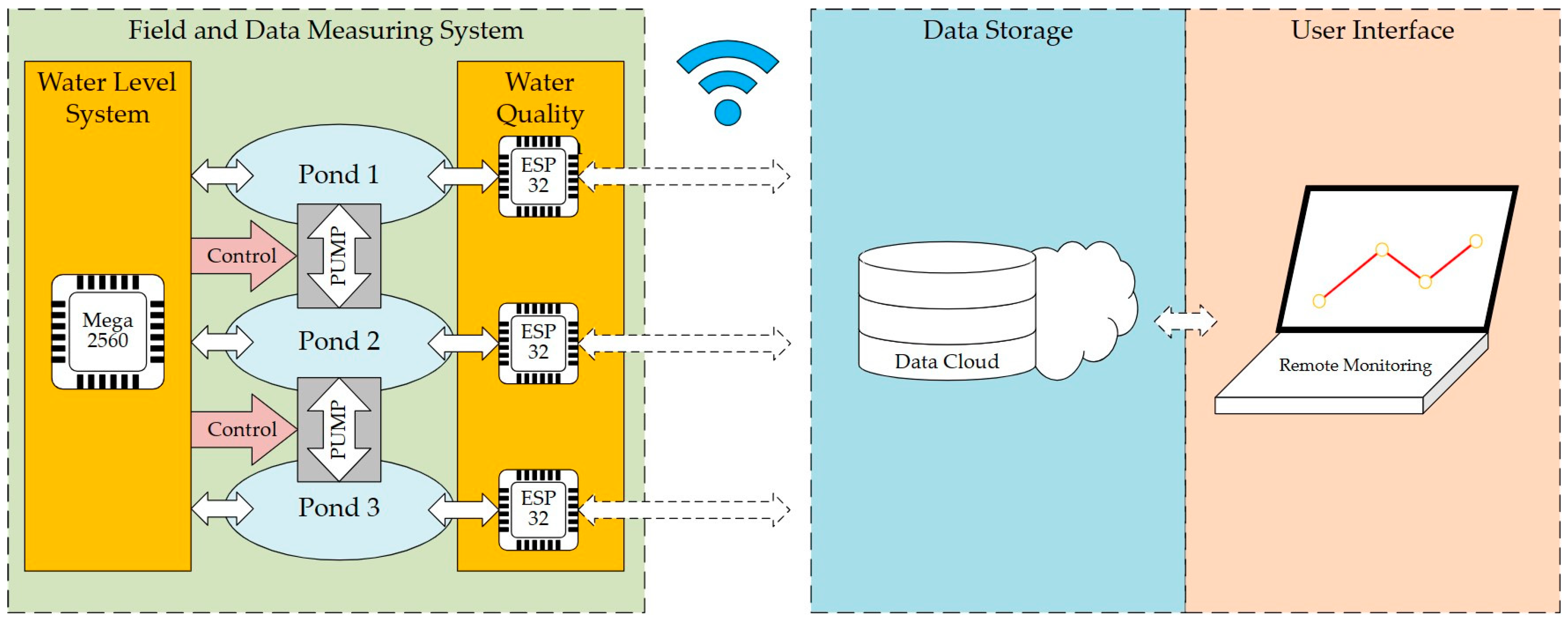



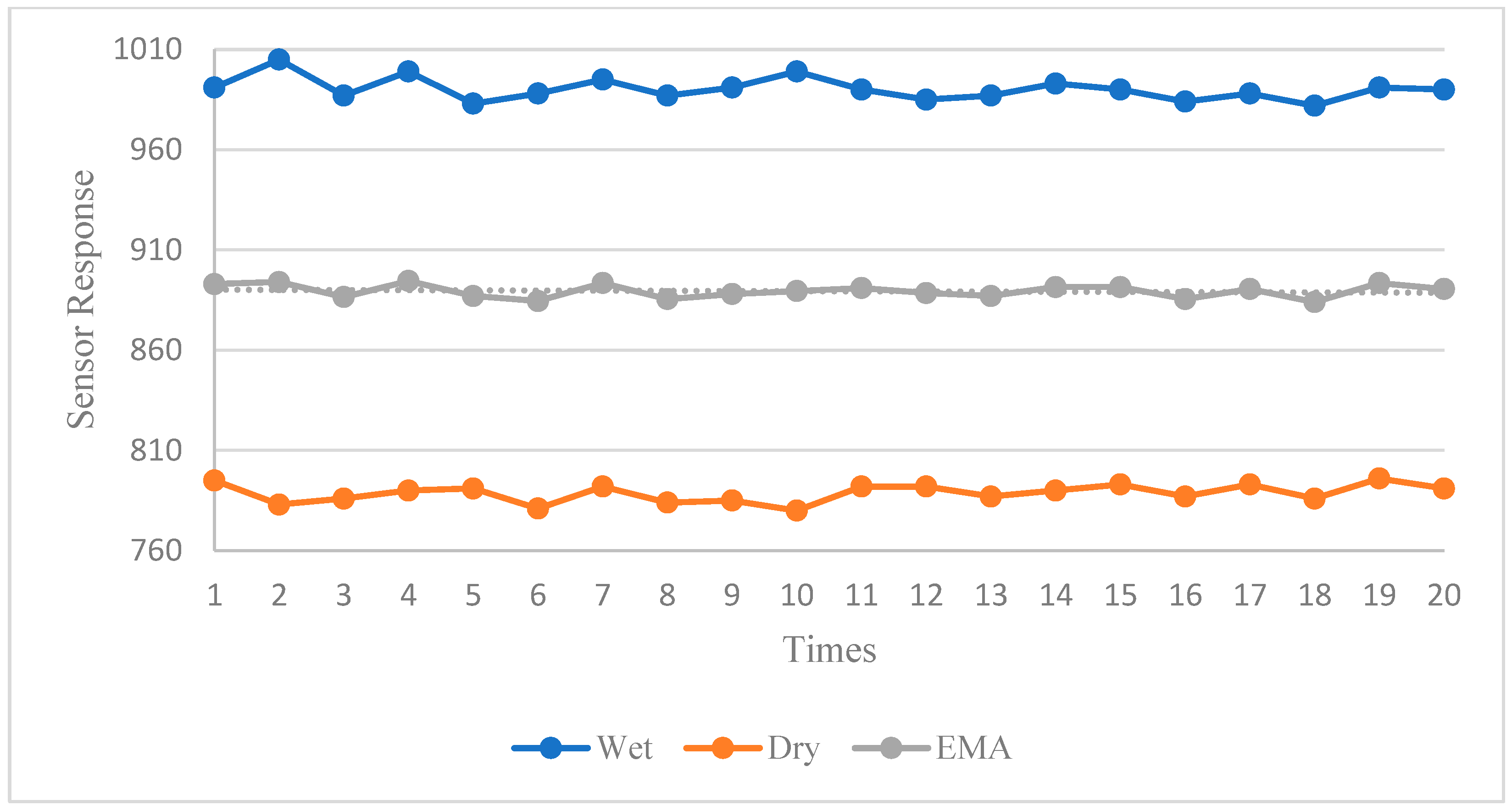


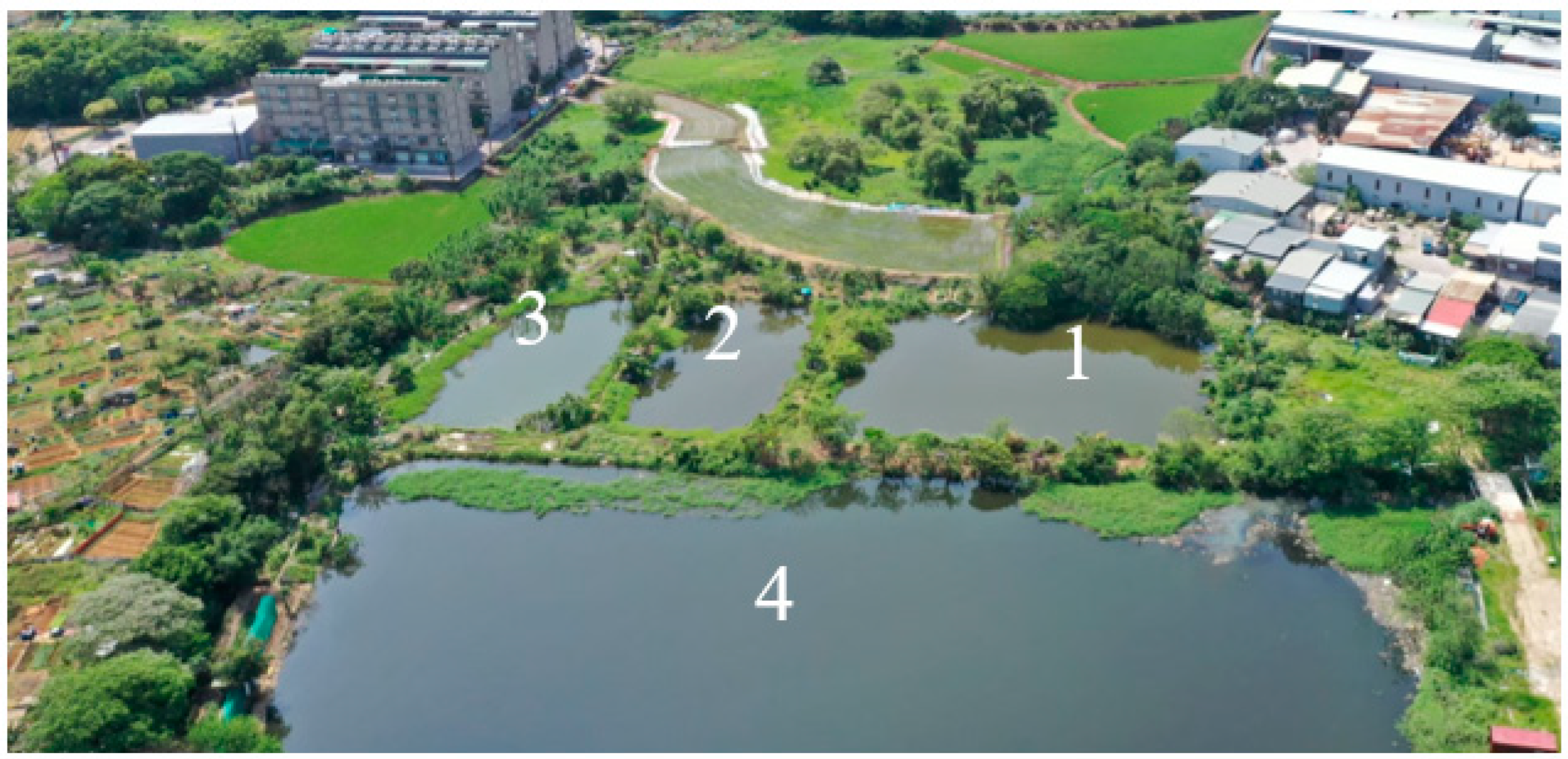
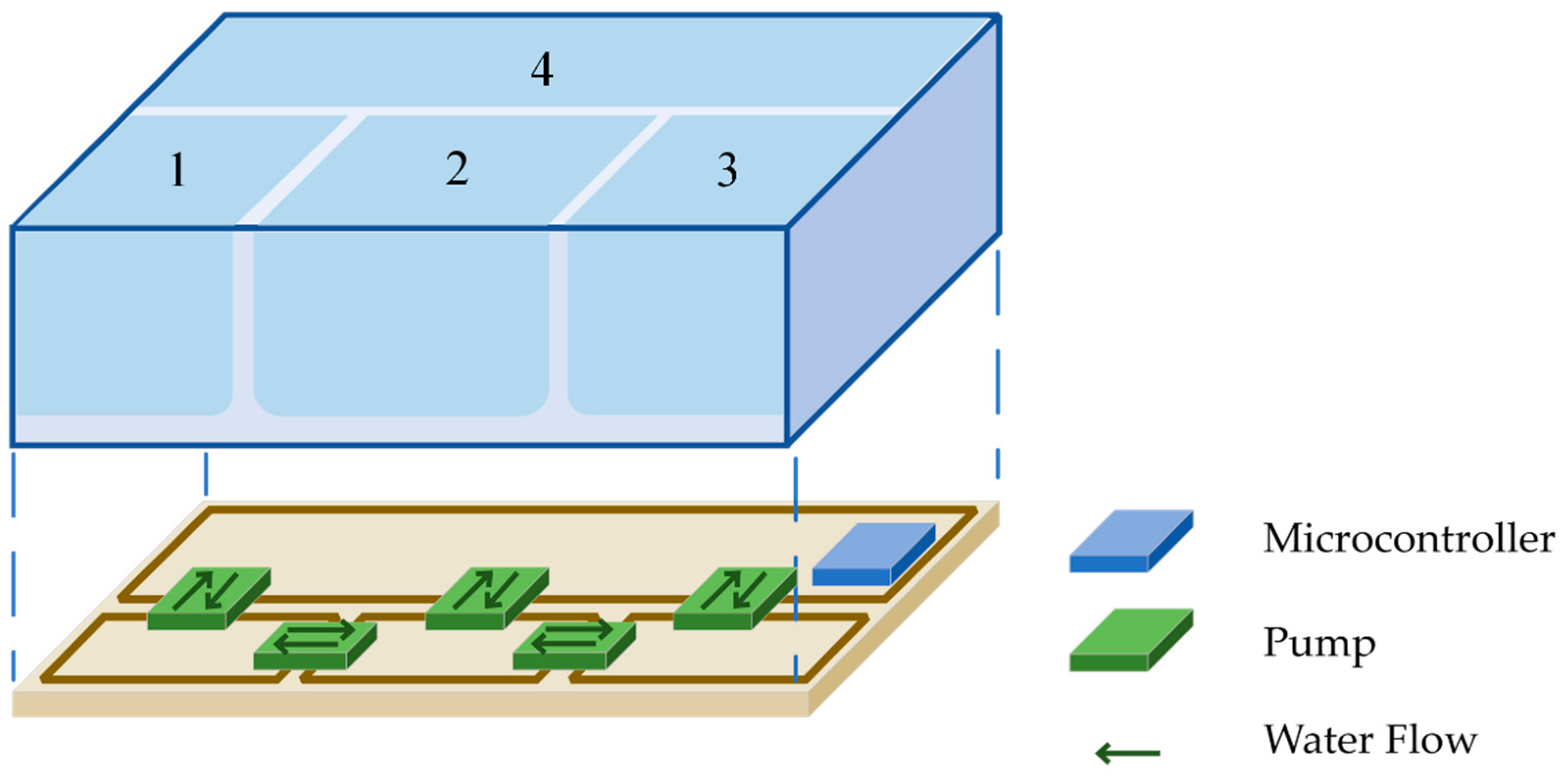

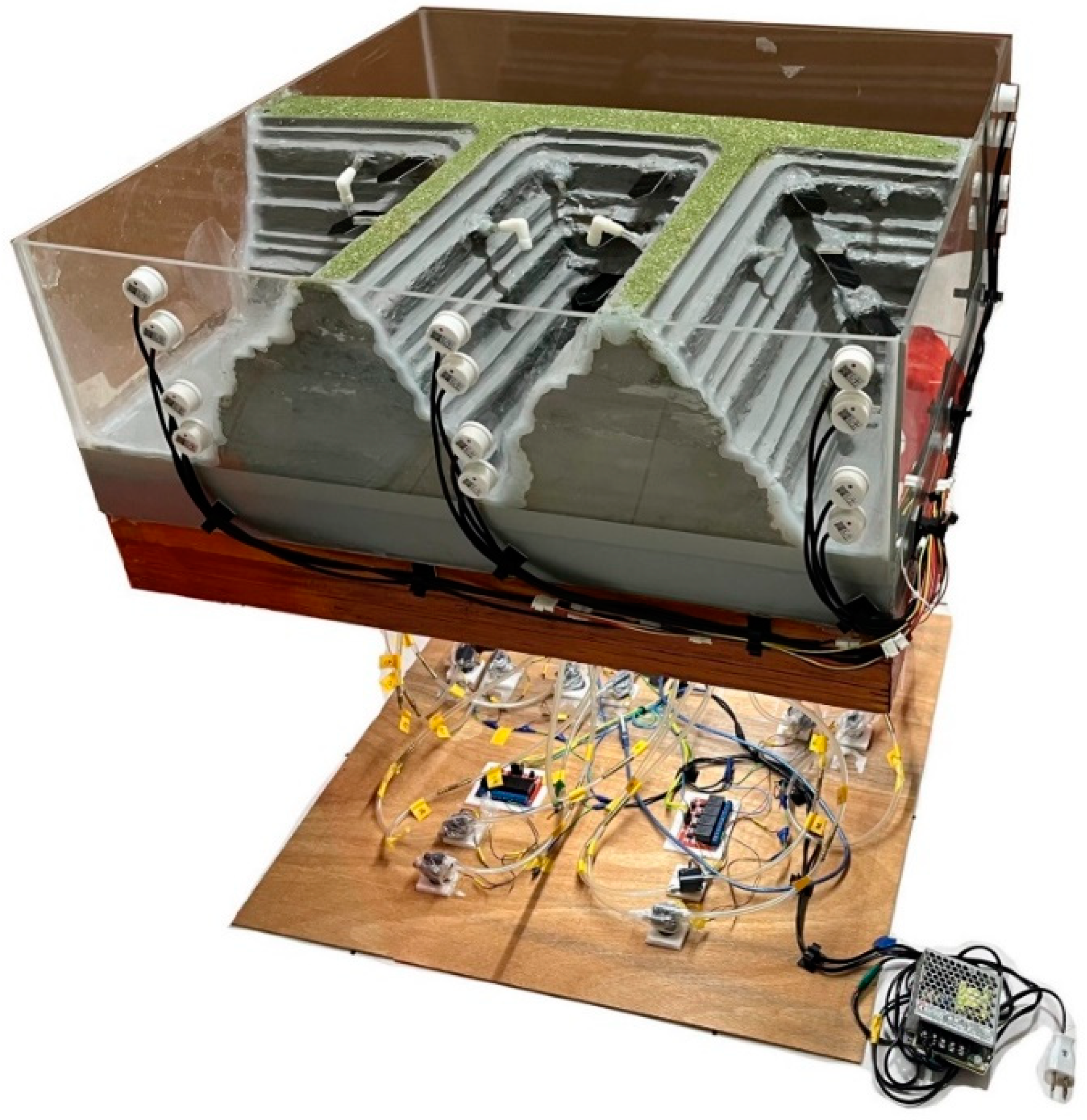
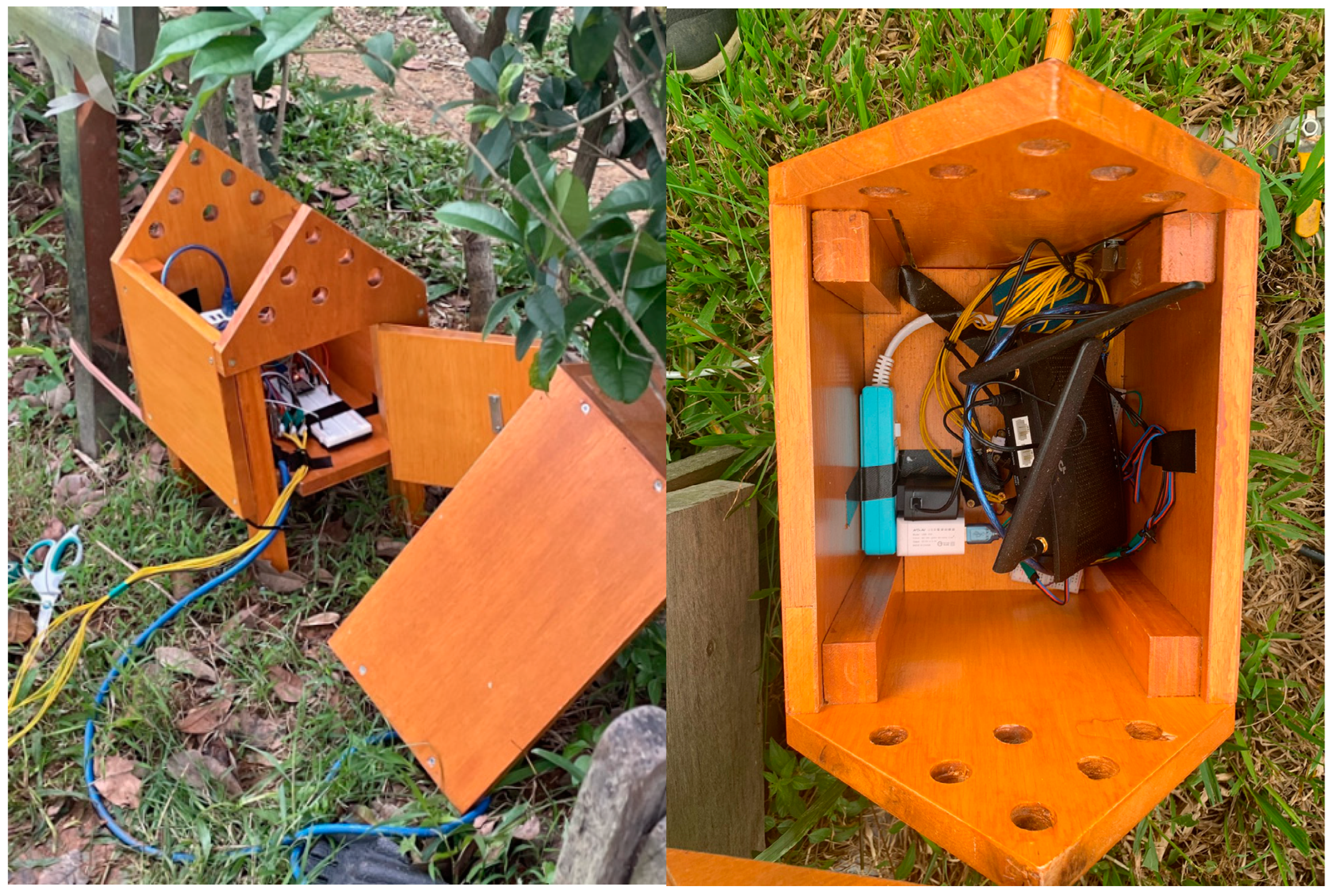

| pH Value | Turbidity | Oxygen |
|---|---|---|
| 6.0~9.0 | 3.1~40 NTU | Above 4.5 mg/L |
| Region’s Level | Status Description |
|---|---|
| 5 | Fully |
| 4 | Sufficient |
| 3 | Normal |
| 2 | Less |
| 1 | Lack |
| Type | Arduino UNO | Arduino Mega 2560 | ESP-32 |
|---|---|---|---|
| Microcontroller Chip | ATmega328 | ATmega2560 | Tensilica 32-bit |
| Operating Voltage | 5 V | 5 V | 3.3 V |
| Input Voltage | 7–12 V | 7–12 V | 7–12 V |
| Digital I/O | 14 | 54 | 28 |
| Analog Input | 6 | 16 | 8 |
| Items | Amount | Each Price | Total Price |
|---|---|---|---|
| pH Sensor | 1 | $40 | $40 |
| Turbidity Sensor | 1 | $15 | $15 |
| Dissolved Oxygen Sensor | 1 | $20 | $20 |
| Soil Moisture Sensor | 4 | $4 | $16 |
| Liquid Level Sensor | 4 | $6 | $24 |
| ESP-32 | 1 | $6 | $6 |
| Mega 2560 | 1 | $12 | $12 |
| Pump | 2 | $7 | $14 |
| $147 |
| Function | [38] | Ours |
|---|---|---|
| pH Monitoring | ◯ | ◯ |
| Dissolved Oxygen Monitoring | ◯ | ◯ |
| Temperature Monitoring | ◯ | ◯ |
| Turbidity Monitoring | X | ◯ |
| Water Level Monitoring | X | ◯ |
| Water Level Control | X | ◯ |
| Price | $308 | $147 |
Disclaimer/Publisher’s Note: The statements, opinions and data contained in all publications are solely those of the individual author(s) and contributor(s) and not of MDPI and/or the editor(s). MDPI and/or the editor(s) disclaim responsibility for any injury to people or property resulting from any ideas, methods, instructions or products referred to in the content. |
© 2023 by the authors. Licensee MDPI, Basel, Switzerland. This article is an open access article distributed under the terms and conditions of the Creative Commons Attribution (CC BY) license (https://creativecommons.org/licenses/by/4.0/).
Share and Cite
Chen, S.-L.; Chou, H.-S.; Huang, C.-H.; Chen, C.-Y.; Li, L.-Y.; Huang, C.-H.; Chen, Y.-Y.; Tang, J.-H.; Chang, W.-H.; Huang, J.-S. An Intelligent Water Monitoring IoT System for Ecological Environment and Smart Cities. Sensors 2023, 23, 8540. https://doi.org/10.3390/s23208540
Chen S-L, Chou H-S, Huang C-H, Chen C-Y, Li L-Y, Huang C-H, Chen Y-Y, Tang J-H, Chang W-H, Huang J-S. An Intelligent Water Monitoring IoT System for Ecological Environment and Smart Cities. Sensors. 2023; 23(20):8540. https://doi.org/10.3390/s23208540
Chicago/Turabian StyleChen, Shih-Lun, He-Sheng Chou, Chun-Hsiang Huang, Chih-Yun Chen, Liang-Yu Li, Ching-Hui Huang, Yu-Yu Chen, Jyh-Haw Tang, Wen-Hui Chang, and Je-Sheng Huang. 2023. "An Intelligent Water Monitoring IoT System for Ecological Environment and Smart Cities" Sensors 23, no. 20: 8540. https://doi.org/10.3390/s23208540
APA StyleChen, S.-L., Chou, H.-S., Huang, C.-H., Chen, C.-Y., Li, L.-Y., Huang, C.-H., Chen, Y.-Y., Tang, J.-H., Chang, W.-H., & Huang, J.-S. (2023). An Intelligent Water Monitoring IoT System for Ecological Environment and Smart Cities. Sensors, 23(20), 8540. https://doi.org/10.3390/s23208540









